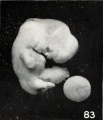Search results
From Embryology
- ===All Carnegie Embryos listed=== [[Category:Carnegie Embryo 6]]5 KB (496 words) - 11:36, 29 July 2018
- ...e>[[Category:Template]][[Category:Reference]][[Category:1940's]][[Category:Carnegie Stage 10]]</noinclude>269 bytes (33 words) - 12:24, 19 May 2017
- | 295 ...ategory:Carnegie Embryo]][[Category:Table]][[Category:Template]][[Category:Carnegie Stage]][[Category:Historic Embryology]]</noinclude>2 KB (128 words) - 17:15, 30 January 2018

File:Mall Meyer1921 fig83.jpg ==Fig. 83. Normal embryo with cyclopia== ...Cyclopia in the human embryo. Contributions to Embryology, No. 15, vol. 6, Carnegie Inst. Wash. Publication 226, p. 5-33. 12, 148, 163, 201, 391, 470, '''559''(464 × 542 (35 KB)) - 05:46, 4 December 2012- | [[:Category:Carnegie Embryo 8698|8698]] | [[Carnegie stage 2|II]] Segmenting egg 2 cells10 KB (1,243 words) - 17:01, 25 February 2017

File:Gage1905-plate5.jpg Fig. 14. From a photograph (X 47%) of Sec. 25 of the human embryo 148 (cf. Figs. 1, 2, 4). It shows: The neural tube just at the ventral bord ...ge model of the nephric region of Homo 148, extending from See. 94 to Sec. 295 (X 75). It shows the two Wolflian ridges, each including the pronephric rem(2,244 × 1,500 (522 KB)) - 14:34, 18 August 2016
File:Gage1905-plate05.jpg Fig. 14. From a photograph (X 47%) of Sec. 25 of the human embryo 148 (cf. Figs. 1, 2, 4). It shows: The neural tube just at the ventral bord ...ge model of the nephric region of Homo 148, extending from See. 94 to Sec. 295 (X 75). It shows the two Wolflian ridges, each including the pronephric rem(979 × 1,500 (271 KB)) - 14:34, 18 August 2016- This {{Embryology}} category shows pages and media related to Carnegie stage 7 of embryonic development. In human development this stage occurs du {{Carnegie stage 7 links}}148 members (9 subcategories, 84 files) - 15:32, 6 August 2017
- ...that in the pluripotent pool of cells of the rat and mouse preimplantation embryo substantial differential regulation of genes is present, which might explai ...gives an approximate comparison of human, mouse and rat embryos based upon Carnegie staging.8 KB (1,166 words) - 10:06, 16 April 2019
- ...in the embryo as at birth, but the deformities of the head and neck of the embryo are of such a nature that it can not survive long enough to admit of compar ...xomphaly. Other anomalies, however, are more difficult to recognize in the embryo as sharply defined malformations.32 KB (4,425 words) - 11:17, 22 November 2012
- ...]]) 17:55, 22 December 2014 (EST) Added [[Model Embryo 7.5mm Movie 1|Human Embryo 7.5mm model]] (Stage 15) from the [[Blechschmidt Collection]]. Added draft ...ll]] ([[User talk:Z8600021|talk]]) 19:38, 15 December 2014 (EST) Added new embryo images [[Carnegie_stage_13#Hill_Collection|Stage 13]] and [[Carnegie_stage_20 KB (2,538 words) - 11:26, 6 July 2015
- ...ryo femur CS18 to CS23.png|thumb|alt=Human embryo femur CS18 to CS23|Human embryo femur CS18 to CS23{{#pmid:31442281|PMID31442281}}]] ...magnetic resonance imaging. The cartilaginous femur was first observed at Carnegie stage 18. Major anatomical landmarks were formed prior to the initiation of27 KB (3,913 words) - 14:35, 21 November 2019
- ...and anus (1914, 57 pages), and a casual report of atresia ani in a 26-mm. embryo (1914). The value of these digestive tube studies is suggested by the fact ...mbryo of twenty-four pairs of somites, received from a Missouri physician (Carnegie Contributions, 1917). He brought back into general use Wepfer’s neglected13 KB (2,152 words) - 14:25, 25 April 2017
- ...and anus (1914, 57 pages), and a casual report of atresia ani in a 26-mm. embryo (1914). The value of these digestive tube studies is suggested by the fact ...mbryo of twenty-four pairs of somites, received from a Missouri physician (Carnegie Contributions, 1917). He brought back into general use Wepfer’s neglected14 KB (2,214 words) - 14:27, 25 April 2017
- ...ention was directed to the problems of these perimedullary cavities in the embryo. ...nitial process of dilatation of the mesenchymal interstices is observed in embryo pigs of 18 to -20 mm.; at a stage of 23 mm., the mesenchymal strands are al15 KB (2,228 words) - 12:21, 4 March 2017
- ...istoric histological study of the development of the meninges of the human embryo spinal cord. Our current understanding of interstitial cell development and ...by the Department of Embryology, sincere appreciation is expressed to the Carnegie Institution of Washington, and to Dr. G. W. Corner, Director. The author is49 KB (7,379 words) - 12:44, 25 July 2020
- ...our own collection of human embryos and fetuses as well as the remarkable Carnegie Collection. ...development which is not necessarily related to the overall length of the embryo.35 KB (5,551 words) - 09:48, 11 March 2018
- ...ht, Sitting Height, Head Size, Foot Length, and Menstrual Age of the Human Embryo= Published by the Carnegie Institution of Washington Washington, 192045 KB (7,551 words) - 13:26, 29 January 2019
- ...Mark_Hill.jpg|90px|left]] This 1935 paper by Gilbert describes early human embryo hypophysis (pituitary) development. ...hms, ’32; Gilbert, ’34). These investigations have shown that in the early embryo the ventral surface ectoderm of the head is closely adherent to the floor40 KB (6,295 words) - 10:10, 26 July 2020
- ...y of fertilization and early cleavage in the human. In vitro fertilization embryo. London: Churchill Livingstone. ...e human. In Trounson, A.O. and Wood, C. (eds.). In Vitro Fertilization and Embryo Transfer. Churchill Livingstone, London.46 KB (6,369 words) - 07:52, 30 December 2018